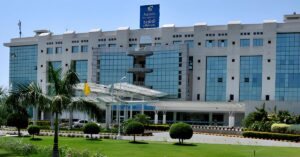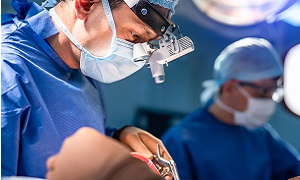Best Doctors in India for Foraminotomy procedure
Best Hospitals in India for Foraminotomy procedure
- City: Mumbai, India
Hospital Highlights:
- Fortis Hiranandani hospital was established in 2007.
- The hospital is an advanced tertiary care, multi-specialty hospital equipped with 149 beds.
- The hospital is equipped with a super ICU to provide emergency medical care to critically ill patients.
- The hospital is NABH accredited.
- The critical care facility in the hospital is augmented with the state-of-the-art facilities that facilitate speedier diagnosis and efficient monitoring.
- The hospital provides specialty medical services in cardiology, orthopedic science, pediatric science, neurology, diabetic care, urology, nephrology, ENT, obstetrics, gynecology, cosmetic surgery, bariatric surgery, neuro and spine care.
- City: Gurugram, India
Hospital Highlights:
- W Pratiksha Hospital, Gurugram, is one of the best hospitals in the NCR region. It is also a top hospital in India for IVF. Since its inception, the hospital has performed over 5500 successful IVFs. The hospital also specializes in gynecology.
- With over 20 years of experience in providing quality healthcare, the hospital is known as one of the most trusted and valued health providers in India.
- Equipped with world-class medical facilities and advanced technology, the hospital’s doctors and clinicians also have a track record of delivering excellent results. The hospital is also known for focusing on preventive well-being as much as on curative treatment.
- The hospital has earned the trust of its patients, by providing the best available treatments at affordable costs.
- City: Gurugram, India
Hospital Highlights:
- Paras hospital was established in 2006 and is the 250 bedded flagship hospital of Paras Healthcare.
- The is supported by a team of doctors of international and national repute.
- The hospital is NABH accredited and also the first hospital in the region to have a NABL accredited laboratory.
- The hospital provides specialty medical services in around 55 departments including Neurosciences, Joint Replacement, Mother & Child Care, Minimal Invasive Surgery, Gynecology and Obstetrics, Ophthalmology, Dermatology, Endocrinology, Rheumatology, Cosmetic and Plastic surgery.
- The hospital is equipped with state-of-the-art technologies.
- City: Kolkata, India
Hospital Highlights:
- Fortis Hospital, Anandapur, Kolkata is a world-class super-speciality equipped with the latest technologies in the medical world.
- The hospital is NABH accredited.
- This state-of-the-art facility specializes in cardiology and cardiac surgery, urology, nephrology, neurosciences, orthopaedics, digestive care, emergency care and critical care.
- The hospital, governed by integrated Building Management System (IBMS), has a pneumatic chute system, for quick vertical and horizontal transportation between floors, facilitating speedy transfer of patient specimens, documents, reports, and medicines to the concerned departments.
- The hospital also has a nephrology department with over 28 advanced dialysis units.
- City: Mumbai, India
Hospital Highlights:
- SL Raheja hospital is a 140-bed multi-specialty tertiary care hospital that is being managed by Fortis Healthcare Ltd.
- The hospital is a benchmark in healthcare and medical facilities in the neighborhood of Mahim & the western suburbs.
- L.Raheja Hospital, Mahim has one of the most effective ICU and Casualty care services.
- The hospital provides specialty medical services in Cardiology, Oncology, Neurology, Orthopedics, Mother & Child Care, and in Diabetes.
- City: Mumbai, India
Hospital Highlights:
- Wockhardt Hospitals were established in the year 1973, originally called First Hospitals and Heart Institute.
- Wockhardt Hospitals are super specialty health care networks in India, nurtured by Wockhardt Ltd, India’s 5th largest Pharmaceutical and Healthcare company.
- Wockhardt Hospitals is associated with Partners Harvard Medical International, an international arm of Harvard Medical School, USA.
- Wockhardt Heart Hospital performed India’s first endoscopic heart surgery.
- The hospital has a state-of-the-art infrastructure equipped with the latest technologies and modern equipment.
- It has special Centers of Excellence dedicated to the major specialties to provide hassle-free and high-quality clinical care.
- City: Gurugram, India
Hospital Highlights:
- The CK Birla Hospital in Gurugram is a NABH-accredited multi-specialty hospital.
- The hospital strives to increase the quality of healthcare by focusing on UK NHS nurse and midwife training requirements. Policies and practices derived from the National Institute for Health and Treatment Excellence (NICE) recommendations in the United Kingdom ensuring that a strong focus on safety, high-quality clinical care, and sanitation is maintained.
- The hospital’s cutting-edge technology and facilities allow for real-time communication and seamless collaboration among caregivers, ensuring accuracy and the best possible results. Those with foreign experience and accreditations make up part of the hospital’s team of clinicians.
- City: Ahmedabad
Hospital Highlights:
- As a member of the Apollo Hospitals Group, Apollo Hospitals International Limited, Ahmedabad is one of the most popular and sought-after medical facilities in Gujarat.
- Through its 6 Centres of Excellence and various affiliated branches, which cover all specialties and subspecialties, the hospital provides the most advanced clinical services.
- Since its inception in 2003, the hospital has been providing each patient with the most up-to-date medical equipment and state-of-the-art technology.
- With more than 150 successful organ transplants, including liver and renal transplants, the facility has been able to build a strong and extensive organ transplant program.
- In addition to performing 600 surgeries and caring for over 1800 patients on an IP basis, the hospital sees more than 18,000 patients on average in the outpatient department.
- With one of the biggest cardiology teams in the area, the hospital provides state-of-the-art regional care treatment in Cardiac Sciences.
- Additionally, the hospital offers a broad range of Neuro Interventional techniques to help stroke patients recover more quickly.
- City: Noida, India
Hospital Highlights:
- Jaypee Hospital is the flagship hospital of the Jaypee Group.
- This hospital has commissioned 525 beds in the first phase and has been planned and designed as a 1200 bedded multi-specialty facility.
- It holds the accreditation of the NABH and NABL.
- The hospital has state-of-the-art infrastructure equipped with the latest technologies and modern equipment like 64 Slice PET CT, Dual Head 6 Slice SPECT CT, Gamma Camera, and Da Vinci Robotic Surgery for comprehensive robotic surgical solutions.
- It has special Centers dedicated to the major specialties to provide hassle-free and high-quality clinical care.
- City: Mumbai, India
Hospital Highlights:
- Reliance Hospital is one of the best super-specialty care hospitals in Navi Mumbai.
- The main purpose of this hospital is to become a trustworthy place for the best health and hope for society. The hospital is well connected to the suburbs of Mumbai and Navi Mumbai.
- The hospital has various specialty departments, viz., Accident & Emergency, Anesthesiology, Dental Services, Dermatology, Diabetology, Dietetics Nutrition, Endocrinology, ENT, Gastroenterology, General Surgery, Gynaecology And Obstetrics, Hepato Pancreato Biliary Surgery, Infectious Disease, Internal Medicine, Interventional Radiology, Laboratory Medicine, Minimal Access Laparoscopic Surgery, Nephrology, Neurosciences, Opthalmology, Orthopaedics, Paediatrics, Pain Management Palliative Care, Physical Medicine Rehabilitation, Plastic And Reconstructive Surgery, Psychiatry, Pulmonary Medicine, Radiology, Rheumatology, Transplant, Urology Andrology, Vascular Surgery
Foraminotomy
Foraminotomy is a surgical procedure which is performed for decompressing i.e. removing pressure on a spinal nerve root.
The term comes from the spine’s foramen, which is the hollow nerve passageways, through which your nerve roots exit the spinal column. The procedure is performed in the thoracic spine, cervical spine as well as in the lumbar spine.
Purpose
Blockages that lead to your spinal column getting narrowed or an intervertebral foramen getting blocked are termed as spinal stenosis. There are various processes which can lead to your intervertebral foramen getting blocked and the nerve getting compressed, leaving the spinal cord.
Conditions that can lead to spinal stenosis include:
- Degeneration of the intervertebral discs, which can cause them to bulge into the foramen
- Cysts or tumors
- Degenerative arthritis of the spine (spondylosis), which can lead to bony spurs
- The nearby ligament getting enlarged
- Skeletal disease
- Congenital problems like dwarfism
Degenerative arthritis of the spine, which comes from old age, is generally the most common cause of spinal stenosis.
This nerve compression might occur along any part of the spinal column. Your compressed nerve might be leading to symptoms, such as pain in the affected region as well as tingling and weakness in your affected limb. A foraminotomy might also be required if you have already tried other treatments but had no success. This can include physical therapy, pain medicines, as well as epidural injections.
Though generally this surgery can be performed as an elective procedure for helping relieve these symptoms, in some cases you might also need to have an emergency foraminotomy if your symptoms get worse quickly or if you are having problems in your bladder caused by your nerves.
Preparation
Your doctor will provide you instructions regarding getting ready for your surgery. Ask him/her if you will need to stop taking any kind of medications, such as blood thinners. You will also need to avoid food and drink after midnight on the night before the procedure.
Before your surgery, your doctor might also order additional imaging tests for getting more information about your nerves and spinal column. Generally, an MRI is the most common test which is performed.
Procedure
The procedure is minimally invasive and can be performed at any level of your spine. Before the procedure, general anesthesia is used.
During the surgery, first, you lie down on the operating table. An incision is first made in the middle of the back of your spine. The length of the incision generally depends on how much of your spinal column is going to be operated on. Skin, muscles as well as ligaments are moved to the side. A surgical microscope is required in some cases so that your surgeon can see the back.
Some bone is cut or shaved away for opening the nerve root opening, i.e. foramen. Disk fragments causing the blockage will be removed. If other bone at the back of your spine also requires removal, your surgeon might need to perform any additional procedure such as laminotomy. Then your surgeon might perform a spinal fusion to make sure that your spine is stable after the surgery. Then the muscles and tissues are put back in place, and the skin is sewn together.
Aftercare & recovery
Few hours after the procedure is done, you should be able to sit up in bed. If there is any pain, you can control it with medications. You should also be able to eat a normal diet unless your doctor recommends against it.
Patients are generally able to go home in a day or two following the procedure. Make sure that you follow your doctor’s instructions regarding wound care, physical activity as well as medications. Sometimes people might also need physical therapy after this procedure. After a few weeks, you should be able to perform light work.
Keep your follow-up appointments with your doctor and discuss with him/her about any new worsening symptoms following foraminotomy.
Around 80-90 percent of patients generally benefit from this surgery and are also able to maintain it long term.
Risks
Though foraminotomy is successful in most people and there is very minimal risk associated with the procedure, in some rare cases, there might be few complications which can include:
- Infection
- Nerve damage
- Damage to the spinal cord
- Excess blood loss
- Stroke
- Complication from anesthesia
Other than these complications, there is also a slight risk that your procedure will not relieve your pain. The risk of complications that arise out of the procedure can generally vary from person to person depending on several conditions such as age, anatomical location of the surgery in the spine, the patient’s medical condition, etc.












